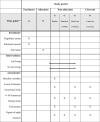Effects of cryotherapy on function, pain intensity, swelling, and dorsiflexion range of motion in acute ankle sprain: Protocol for the FROST randomised controlled trial
- PMID: 40465705
- PMCID: PMC12136321
- DOI: 10.1371/journal.pone.0325456
Effects of cryotherapy on function, pain intensity, swelling, and dorsiflexion range of motion in acute ankle sprain: Protocol for the FROST randomised controlled trial
Abstract
Background: Cryotherapy is a low-cost treatment option recommended by clinical practice guidelines in acute ankle sprain. However, the current quality of the evidence that supports cryotherapy is still unclear. New high-quality randomised controlled trials are needed. The aim of the Freeze On Sprain Trial (FROST) is to investigate the effectiveness of cryotherapy on function, pain intensity, swelling and dorsiflexion range of motion in people with an acute episode of ankle sprain.
Methods: This is a protocol of a two-arm randomised controlled trial. Eighty-two participants over 18 years old presenting grade I or II ankle sprain up to 72 hours from the episode will be randomly allocated to Ice Group (i.e., home prescription to apply cryotherapy on the injured ankle with elevation plus non-steroidal anti-inflammatory medication - NSAID) or No Ice Group (i.e., elevation plus NSAID). Our primary outcome is function measured by the Lower Extremity Functional Scale (LEFS) questionnaire. Our secondary outcomes are pain intensity (11-point numerical rating scale), swelling (figure-of-eight method) and dorsiflexion range of motion (goniometry). Participants will be assessed at baseline, 24 hours, 7-10 days, and 12 weeks after allocation. The analysis will follow the intention-to-treat principle using linear mixed models.
Discussion: The results of this study will clarify the effectiveness of cryotherapy in acute ankle sprain for better clinical decision-making processes.
Trial registration: Brazilian Clinical Trials Registry (REBEC) RBR-8v9gr9c.
Copyright: © 2025 Miranda et al. This is an open access article distributed under the terms of the Creative Commons Attribution License, which permits unrestricted use, distribution, and reproduction in any medium, provided the original author and source are credited.
Conflict of interest statement
The authors have declared that no competing interests exist.
Figures
References
-
- Gribble PA, Bleakley CM, Caulfield BM, Docherty CL, Fourchet F, Fong DT-P, et al.. Evidence review for the 2016 International Ankle Consortium consensus statement on the prevalence, impact and long-term consequences of lateral ankle sprains. Br J Sports Med. 2016;50(24):1496–505. doi: 10.1136/bjsports-2016-096189 - DOI - PubMed
-
- Costantino C, Kwarecki J, Samokhin AV, Mautone G, Rovati S. Diclofenac epolamine plus heparin plaster versus diclofenac epolamine plaster in mild to moderate ankle sprain: a randomized, double-blind, parallel-group, placebo-controlled, multicentre, phase III trial. Clin Drug Investig. 2011;31(1):15–26. doi: 10.2165/11585890-000000000-00000 - DOI - PubMed
-
- van Dijk CN. CBO-guideline for diagnosis and treatment of the acute ankle injury. National organization for quality assurance in hospitals. Ned Tijdschr Geneeskd. 1999;143(42):2097–101. - PubMed
Publication types
MeSH terms
Substances
LinkOut - more resources
Full Text Sources
Medical


